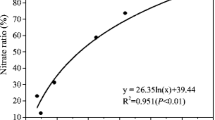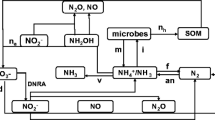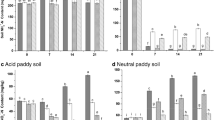Abstract
Purpose
In the rice soils, the alternate wetting and drying conditions and the leakage of O2 from rice roots provides a favorable environment for many N transformation processes, such as DNRA, nitrification, mineralization, and denitrification. Since nitrification is an inevitable process providing available NO3 − for DNRA and other NO3 − loss pathways, it is logical to hypothesize that a relationship exists between nitrification and DNRA. Thus, we quantified the specific gross N transformation rates occurring simultaneously to investigate the correlation among the N transformation rates in the rice soil.
Material and methods
In this study, three rice soils with different pH values were selected. The combination of 15N tracing experiment and numerical modeling method was performed to quantify the specific gross N transformation rates (e.g., DNRA), to analyze the correlation between DNRA and the other N transformations, and to estimate the functional role of DNRA comparing to other N transformation in the rice soil.
Results and discussion
The results showed that there were two NH4 + production pathways, organic N mineralization and DNRA, in the neutral (pH 6.2) and alkaline (pH 8.2) soils, while the DNRA process was negligible in acidic soil (pH 4.7). The mineralization rate in the acidic soil (2.69 mg kg−1d−1) was significantly higher than that in neutral and alkaline soils. The DNRA rate was 0.48 and 1.09 mg kg−1d−1, which was almost equal to the mineralization rate, in the neutral (pH 6.2) and alkaline (pH 8.2) soils, offsetting efficiently the effect of low mineralization on N availability in ecosystems. The DNRA rate linearly increased with the increase in gross nitrification rate (p < 0.05). This significant coupling relationship between DNRA and nitrification favors N conservation and availability for paddy growth in the rice ecosystem.
Conclusions
DNRA plays an important role in soil N conservation and availability in neutral and alkaline but not acidic rice soil.






Similar content being viewed by others
References
Bengtsson G, Bergwall C (2000) Fate of 15N labeled nitrate and ammonium in a fertilized forest soil. Soil Biol Biochem 32:545–557
Booth MS, Stark JM, Rastetter E (2005) Controls on nitrogen cycling in terrestrial ecosystems: a synthetic analysis of literature data. Ecol Monogr 75:139–157
Burger M, Jackson LE (2004) Plant and microbial use and turnover: rapid conversion of nitrate to ammonium in soil with roots. Plant Soil 266:289–301
Burgin AJ, Hamilton SK (2007) Have we overemphasized the role of denitrification in aquatic ecosystems? A review of nitrate removal pathways. Front Ecol Environ 5(2):89–96
Cheng Y, Wang J, Mary B, Zhang J, Cai Z (2013) Soil pH has contrasting effects on gross and net nitrogen mineralizations in adjacent forest and grassland soils in central Alberta, Canada. Soil Biol Biochem 57:848–857
Fazzolari É, Nicolardot B, Germon JC (1998) Simultaneous effects of increasing levels of glucose and oxygen partial pressures on denitrification and dissimilatory reduction to ammonium in repacked soil cores. Eur J Soil Biol 34:47–52
Frenzel P, Rothfuss F, Conrad R (1992) Oxygen profiles and methane turnover in a flooded rice microcosm. Biol Fertil Soils 14:84–89
Gilbert B, Frenzel P (1995) Methanotrophic bacteria in the rhizosphere of rice microcosms and their effect on porewater methane concentration and methane emission. Biol Fertil Soils 20:93–100
Huygens D, Rütting T, Boeckx P, Van Cleemput O, Godoy R, Müller C (2007) Soil nitrogen conservation mechanisms in a pristine south Chilean Nothofagus ecosystem. Soil Biol Biochem 39:2448–2458
Huygens D, Boeckx P, Templer PH, Paulino L, Van Cleemput O, Oyarzún CE, Müller C, Godoy R (2008) Mechanisms for retention of bioavailable nitrogen in volcanic rainforest soil. Nat Geosci 1:543–548
Karim AQMB, Vlamis J (1962) Comparative study of the effects of ammonium and nitrate nitrogen in the nutrition of rice. Plant Soil 16:32–41
Katyal JC, Carter ME, Vlek PLG (1988) Nitrification activity in submerged soils and its relation to denitrification loss. Biol Fertil Soils 7:16–22
Linn DM, Doran JW (1984) Effect of water-filled pore space on carbon dioxide and nitrous oxide production in tilled and non-tilled soils. Soil Sci Soc Am J 48:1267–1272
Lu RK (2000) Soil Agro-Chemical Analyses. Agricultural Technical Press of China, Beijing (in Chinese)
Müller C, Rütting T, Kattge J, Laughlin RJ, Stevens RJ (2007) Estimation of parameters in complex 15N tracing models via Monte Carlo sampling. Soil Biol Biochem 39:715–726
Müller C, Laughlin RJ, Spott O, Rütting T (2014) Quantification of N2O emission pathways via a 15N tracing model. Soil Biol Biochem 72:44–54
Pett-Ridge J, Silver WL, Firestone MK (2006) Redox fluctuations frame microbial community impacts on N-cycling rates in humid tropical forest soil. Biogeochemistry 81:95–110
Reddy KR, Patrick WH (1986) Fate of fertilizer nitrogen in the rice root zone. Soil Sci Soc Am J 50:649–651
Reddy KR, Patrick WH, Lindau CW (1989) Nitrification-denitrification at the plant root-sediment interface in wetlands. Limnol Oceanogr 34(6):1004–1013
Revsbech NP, Pedersen O, Reichardt W, Briones A (1999) Microsensor analysis of oxygen and pH in the rice rhizosphere under field and laboratory conditions. Biol Fertil Soils 29:379–385
Rütting T, Huygens D, Müller C, van Cleemput O, Godoy R, Boeckx P (2008) Functional role of DNRA and nitrite reduction in a pristine south Chilean Nothofagus forests. Biogeochemistry 90:243–258
Rütting T, Boeckx P, Müller C, Klemedtsson L (2011) Assessment of the importance of dissimilatory nitrate reduction to ammonium for the terrestrial nitrogen cycle. Biogeosciences 8:1779–1791
Savant NK, De Datta SK (1982) Nitrogen transformations in wetland rice soils. Adv Agron 35:241–302
Silver WL, Herman DJ, Firestone MK (2001) Dissimilatory nitrification reduction to ammonium in upland tropical forest soils. Ecology 82(9):2410–2416
Sotta ED, Corre MD, Veldkamp E (2008) Differing N status and N retention processes of soils under old-growth lowland forest in Eastern Amazonia, Caxiuanã, Brazil. Soil Biol Biochem 40:740–750
Stevens RJ, Laughlin RJ, Malone JP (1998) Soil pH affects the processes reducing nitrate to nitrous oxide and di-nitrogen. Soil Biol Biochem 30:1119–1126
Templer PH, Silver WL, Pett-Ridge J, DeAngelis KM, Firestone MK (2008) Plant and microbial controls on nitrogen retention and loss in a humid tropical forest. Ecology 89:3030–3040
Tiedje JM (1988) Ecology of denitrification and of dissimilatory nitrate reduction to ammonium. In: Zehnder AJB (ed) Biology of anaerobic microorganisms. John Wiley and Sons, Inc., New York, NY, pp 179–244
Weber DF, Gainey PL (1962) Relative sensitivity of nitrifying organisms to hydrogen ions in soils and solutions. Soil Sci 94:138–145
Yin SX, Chen D, Chen LM, Edis R (2002) Dissimilatory nitrate reduction to ammonium and responsible microorganisms in two Chinese and Australian paddy soils. Soil Biol Biochem 34:1131–1137
Zhang J, Zhu T, Cai Z, Müller C (2011) Nitrogen cycling in forest soils across climate gradients in Eastern China. Plant Soil 342:419–432
Zhang J, Zhu T, Cai Z, Qin S, Müller C (2012) Effects of long-term repeated mineral and organic fertilizer applications on soil nitrogen transformations. Eur J Soil Sci 63:75–85
Zhang J, Cai Z, Zhu T, Yang W, Müller C (2013a) Mechanisms for the retention of inorganic N in acidic forest soils of southern China. Sci Rep 3:2342. doi:10.1038/srep02342
Zhang J, Zhu T, Meng T, Zhang Y, Yang J, Yang W, Müller C, Cai Z (2013b) Agricultural land use affects nitrate production and conservation in humid subtropical soils in China. Soil Biol Biochem 62:107–114
Acknowledgments
This work was supported by grants from the National Natural Science Foundation of China (41330744 and 41222005), the Natural Science Foundation of Jiangsu Province (BK20140062), the Natural Science Foundation of the Jiangsu Higher Education Institutions of China (13KJA210002), the Priority Academic Program Development of Jiangsu Higher Education Institutions (PAPD), and the outstanding innovation team in Colleges and universities in Jiangsu Province.
Author information
Authors and Affiliations
Corresponding authors
Additional information
Responsible editor: Zhihong Xu
Rights and permissions
About this article
Cite this article
Zhang, J., Lan, T., Müller, C. et al. Dissimilatory nitrate reduction to ammonium (DNRA) plays an important role in soil nitrogen conservation in neutral and alkaline but not acidic rice soil. J Soils Sediments 15, 523–531 (2015). https://doi.org/10.1007/s11368-014-1037-7
Received:
Accepted:
Published:
Issue Date:
DOI: https://doi.org/10.1007/s11368-014-1037-7




